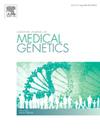A rare triplication of 16p11.2: Unravelling the genomic complexity and review of the literature
IF 1.7
4区 医学
Q3 GENETICS & HEREDITY
引用次数: 0
Abstract
16p11.2 triplication is a rare chromosomal disorder associated with developmental delay, behavioral abnormalities, and various dysmorphic features. Here, we present a case study of a four-year-old girl with 16p11.2 triplication, whose healthy father has a smaller 16p11.2 duplication that partially overlaps with that of the daughter. She has a global developmental delay, autism spectrum disorder, anxiety, and sensory processing issues, alongside dysmorphic features. Genetic analysis revealed triplication within the 16p11.2 duplication region. We used different technical approaches to pinpoint the exact genetic architecture of the triplication and to gain further functional insights. Using array-CGH and Fluorescence In Situ Hybridization (FISH), we detected the location of the triplication. We later sought to confirm this with Oxford Nanopore Technologies (ONT); however, detecting duplications and triplications proved to be challenging. Finally, RNA sequencing showed overexpression of genes within the triplication region, including INO80E, PAGR1, SPN, KIF22, HIRIP3, TAOK2, and TMEM219, some of which had been associated with neurodevelopmental disorders and/or increased body mass index by GWAS (1). Our findings contribute to the understanding of the phenotypic spectrum and molecular mechanisms of 16p11.2 triplication. Moreover, the challenges in detecting triplications using current sequencing methods highlight the need for improved diagnostic techniques.
罕见的16p11.2的三倍:揭示基因组的复杂性和文献回顾
16p11.2重复是一种罕见的染色体疾病,与发育迟缓、行为异常和各种畸形特征有关。在这里,我们提出了一个病例研究,一个4岁的女孩有16p11.2三倍,其健康的父亲有一个较小的16p11.2重复,部分重叠的女儿。她有全面发育迟缓、自闭症谱系障碍、焦虑和感觉处理问题,以及畸形特征。遗传分析显示在16p11.2重复区域内存在三倍复制。我们使用不同的技术方法来确定三倍的确切遗传结构,并获得进一步的功能见解。使用阵列- cgh和荧光原位杂交(FISH),我们检测了三倍的位置。我们后来与牛津纳米孔技术公司(ONT)确认了这一点;然而,检测重复和重复被证明是具有挑战性的。最后,RNA测序显示在三倍复制区域内的基因过表达,包括INO80E、PAGR1、SPN、KIF22、HIRIP3、TAOK2和TMEM219,其中一些基因与GWAS引起的神经发育障碍和/或体重指数增加有关(1)。我们的研究结果有助于理解16p11.2三倍复制的表型谱和分子机制。此外,使用当前的测序方法检测重复的挑战突出了改进诊断技术的必要性。
本文章由计算机程序翻译,如有差异,请以英文原文为准。
求助全文
约1分钟内获得全文
求助全文
来源期刊
CiteScore
4.10
自引率
0.00%
发文量
193
审稿时长
66 days
期刊介绍:
The European Journal of Medical Genetics (EJMG) is a peer-reviewed journal that publishes articles in English on various aspects of human and medical genetics and of the genetics of experimental models.
Original clinical and experimental research articles, short clinical reports, review articles and letters to the editor are welcome on topics such as :
• Dysmorphology and syndrome delineation
• Molecular genetics and molecular cytogenetics of inherited disorders
• Clinical applications of genomics and nextgen sequencing technologies
• Syndromal cancer genetics
• Behavioral genetics
• Community genetics
• Fetal pathology and prenatal diagnosis
• Genetic counseling.

 求助内容:
求助内容: 应助结果提醒方式:
应助结果提醒方式:


